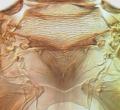Dendrothrips howei
Recognition data
Distinguishing features
Both sexes fully winged. Female body colour brown, head and thorax darker than abdomen; legs brown, tarsi yellow; antennal segment II darkest, III and IV almost yellow; fore wing white in basal fifth, then brown to apex. Head transverse, reticulate near stout occipital ridge; ocellar region with tuberculate not reticulate sculpture; two pairs of ocellar setae, both just outside lateral margins of triangle. Antennae with eight segments (sometimes with VII–VIII almost fused), III and IV each with a small forked sensorium that arises ventrally on both segments. Pronotum transverse, with transverse reticulation and markings within each reticle; all setae small, slightly thickened and blunt. Metanotum with irregular reticulation. Fore wing veinal setae small, no longer than twice the length of the microtrichia, but blunt or slightly spatulate. Tergites with transversely reticulate sculpture laterally, the lines bearing small linear ridges; VIII with a posteromarginal comb of microtrichia, V–VII with a similar small comb medially. Sternites with three pairs of small marginal setae.
Male similar to female in colour and sculpture, but smaller with abdomen paler and more slender; tergite IX with a pair of long setae close together medially and two pairs of long discal setae closer to posterior margin; sternites with no pore plates.
Related and similar species
There are 52 species listed in the genus Dendrothrips, none of which is native to any part of the Americas. Most of them are known from Africa and Asia, with nine species from Europe (zur Strassen, 2003), and four from Australia (Marullo, 2003). These thrips all have the metathoracic furca elongate and "lyre-shaped" as in other members of the Dendrothripinae (Mound, 1999). However, in Dendrothrips species the forewing is unusual with the antero-marginal cilia arising ventral to the apparent anterior margin.
Taxonomic data
Current valid name
Dendrothrips howei Mound
Original name and synonyms
- Dendrothrips howei Mound, 1999: 264
Family placement
Thripidae, Dendrothripinae
Biological data
Life history
Breeding on leaves
Host plants
Xylosma maideni, X. congestum (Flacoutiaceae), Malaisia scandens (Moraceae); a few adults taken from Smilax australis (Smilacaceae).
Tospoviruses vectored
None
Crop damage
Causing leaf damage to Xylosma plants in California.
Distribution data
Area of origin
Lord Howe Island, Australia.
Distribution
Australia; in 2012 recognised as established in California, presumably from greenhouse nursery plants.







